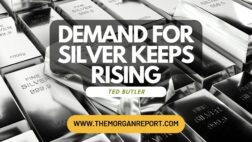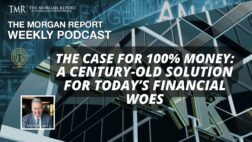Richard (Rick) Mills
Ahead of the Herd
As a general rule, the most successful man in life is the man who has the best information
A critical or strategic material is a commodity whose lack of availability during a national emergency would seriously affect the economic, industrial, and defensive capability of a country.
The report “Critical Raw Materials for the EU” listed 14 raw materials which they deemed critical to the European Union (EU): antimony, beryllium, cobalt, fluorspar, gallium, germanium, graphite, indium, magnesium, niobium, platinum group metals, rare earths, tantalum and tungsten.
The French Bureau de Recherches Géologiques et Minières rates high tech metals as critical, or not, based on three criteria:
- Possibility (or not) of substitution
- Irreplaceable functionality
- Potential supply risks
Demand is increasing for critical metals due to:
- Economic growth of developing countries
- Emergence of new technologies and products
Access to raw materials at competitive prices has become essential to the functioning of all industrialized economies. As we move forward developing and developed countries will, with their:
- Massive population booms
- Infrastructure build out and urbanization plans
- Modernization programs for existing, tired and worn out infrastructure
Continue to place extraordinary demands on our ability to access and distribute the planets natural resources.
Threats to access and distribution of these commodities could include:
- Political instability of supplier countries
- The manipulation of supplies
- The competition over supplies
- Attacks on supply infrastructure
- Accidents and natural disasters
- Climate change
Accessing a sustainable, and secure, supply of raw materials is going to become the number one priority for all countries. Increasingly we are going to see countries ensuring their own industries have first rights of access to internally produced commodities and they will look for such privileged access from other countries.
Numerous countries are taking steps to safeguard their own supply by:
- Stopping or slowing the export of natural resources
- Shutting down traditional supply markets
- Buying companies for their deposits
- Project finance tied to off take agreements
Many countries classify cobalt as a critical or a strategic metal.
The US is the world’s largest consumer of cobalt and the US also considers cobalt a strategic metal. The US has no domestic production – the United States is 100% dependent on imports for its supply of primary cobalt – currently about 15% of U.S. cobalt consumption is from recycled scrap, resulting in a net import reliance of 85%.
Although cobalt is one of the 30 most abundant elements within the earth’s crust it’s low concentration (.002%) means it’s usually produced as a by-product – cobalt is mainly obtained as a by-product of copper and nickel mining activities.
Today 40% of the cobalt consumed in the world originated as a by-product from copper production in the West African country of the Democratic Republic of Congo (DRC) – cobalt production in most other countries is a by-product of nickel mining.
The copper deposits in the Katanga Province of the Democratic Republic of the Congo are the top producers of cobalt and the political situation in the Congo influences the price of cobalt significantly. The politically unstable Democratic Republic of Congo contains half the world’s cobalt supply and represents the lion’s share of anticipated future cobalt supply – the DRC’s 2007 output was equal to the combined production of cobalt by Canada, Australia and Zambia.
In a nine billion dollar joint venture with the DRC China got the rights to the vast copper and cobalt resources of the North Kivu in exchange for providing $6 billion worth of road construction, two hydroelectric dams, hospitals, schools and railway links to southern Africa, to Katanga and to the Congo Atlantic port at Matadi. The other $3 billion is to be invested by China in development of new mining areas. Approximately half of known global cobalt reserves are in the DRC, and close to 40%-50% of incremental cobalt production, over the next five years, is anticipated to emanate from the DRC.
At 19.7 percent of global supply Zambia is the world’s second largest producer of copper-cobalt. According to a recently released report by the Zambian Central Bank cobalt production rose to 2,236 tons in the first quarter of 2011 from 1,989 tons last year, exports increased to 2,279 from 1,977.
China is extremely short of cobalt concentrates and needs to import cobalt concentrates in large amounts every year. The leading global producers of refined cobalt are China (39%), Finland (15%) and Canada (8%). China is a leading supplier of cobalt imports to the United States.
The cobalt market is small in comparison with other base metals. Consumers purchase cobalt through negotiated agreements, bids, and open markets from producers, traders and to a lesser degree, government stockpiles and private inventories.
Uses
Cobalt is a strategic and critical metal used in many diverse industrial and military applications.
- Super alloys
- Renewable Energy Re-usable energy storage systems
- Wear resistant alloys
- Magnets
- Binder Material
- Thermal spray coatings
- Orthopedics
- Life Science
- Catalyst in de-sulfurizing crude oil and as a catalyst in hydrogenation, oxidation, reduction, and synthesis of hydrocarbons.
- Gas to liquid technology (GLT)
- Other Uses – Drying agents in paints, de-colorizers, dyes, pigments, and oxidizers. Promotes adherence of enamel to steel, and steel to rubber in steel belted radial tires
Conclusion
China seemingly has most of the DRC’s production of cobalt locked up, that’s up to 40% of global mined cobalt.
Cobalt is classified as a strategic/critical metal.
With the recent strong support for electric vehicles the use of cobalt in this sector alone has led to a formidable demand for the element and the US cannot continue to depend on its cobalt being supplied mostly from China.
There is no doubt in this author’s mind that cobalt’s profile will continue growing in the coming months and years.
Is cobalt on your radar screen?
If not maybe it should be.
Richard (Rick) Mills
rick@aheadoftheherd.com
www.aheadoftheherd.com
If you’re interested in learning more about the junior resource, bio-tech and technology sectors please come and visit us at www.aheadoftheherd.com
Site membership, and our AOTH newsletter, are free. No credit card or personal information is asked for.
***
Richard is host of Aheadoftheherd.com and invests in the junior resource sector. His articles have been published on over 300 websites, including: Wall Street Journal, SafeHaven, Market Oracle, USAToday, National Post, Stockhouse, Lewrockwell, Uranium Miner, Casey Research, 24hgold, Vancouver Sun, SilverBearCafe, Infomine, Huffington Post, Mineweb, 321Gold, Kitco, Gold-Eagle, The Gold/Energy Reports, Calgary Herald, Resource Investor, Mining.com, Forbes, FNArena, Uraniumseek, and Financial Sense.
***
Legal Notice / Disclaimer
This document is not and should not be construed as an offer to sell or the solicitation of an offer to purchase or subscribe for any investment. Richard Mills has based this document on information obtained from sources he believes to be reliable but which has not been independently verified; Richard Mills makes no guarantee, representation or warranty and accepts no responsibility or liability as to its accuracy or completeness. Expressions of opinion are those of Richard Mills only and are subject to change without notice. Richard Mills assumes no warranty, liability or guarantee for the current relevance, correctness or completeness of any information provided within this Report and will not be held liable for the consequence of reliance upon any opinion or statement contained herein or any omission. Furthermore, I, Richard Mills, assume no liability for any direct or indirect loss or damage or, in particular, for lost profit, which you may incur as a result of the use and existence of the information provided within this Report.
For site advertising rates contact: rick@aheadoftheherd.com
Richard Mills does not own shares of any companies mentioned in this report.



